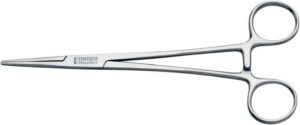The Kelly clamp is a surgical instrument used to clamp larger blood vessels or tissues during surgical procedures. It is named after the American surgeon, Howard Kelly, who is known for his contributions to the field of gynecology.
Parts of Kelly clamp
The Kelly clamp consists of two curved jaws with serrated edges that are used to grip and hold blood vessels or tissues. The jaws are hinged together and can be locked in place using a ratcheting mechanism located at the end of the instrument. The instrument is typically used in surgical procedures to control bleeding and provide a clear view of the surgical site.
Uses of clamp
The Kelly clamp is a versatile instrument that can be used for a variety of surgical procedures, including general surgery, gynecological surgery, and orthopedic surgery. It is particularly useful in procedures where larger blood vessels or tissues need to be clamped without causing damage to the surrounding structures. The Kelly artery forceps are used in clamping the vessels and resecting tissues for extraction. Used in cases like Hysterectomies and in abdominal surgery
Precautions
However, like any surgical instrument, the use of a Kelly clamp requires skill and precision, as improper use can cause damage to the surrounding tissues and structures. It is important for the surgeon to receive proper training and follow proper safety protocols when using this instrument to ensure the best possible outcome for the patient.
In conclusion, the Kelly clamp is a surgical instrument used to clamp larger blood vessels or tissues during surgical procedures. It consists of two curved jaws with serrated edges that are hinged together and can be locked in place using a ratcheting mechanism. While the use of this instrument can be beneficial in certain surgical procedures, proper training and safety protocols are essential to minimize the risk of complications and ensure the best possible outcome for the patient.
